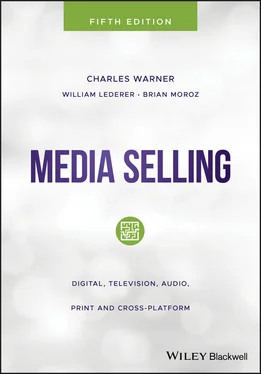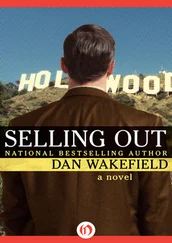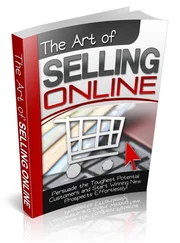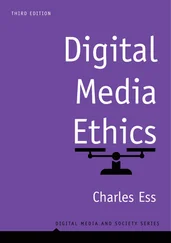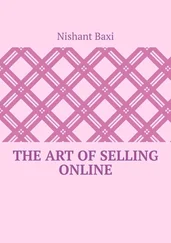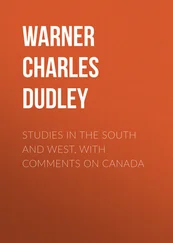1 ...6 7 8 10 11 12 ...36 1 What is purpose of a business?
2 In marketing, what is the primary focus?
3 What was AdWords?
4 Why is Facebook so profitable?
5 What is the difference between a customer and a consumer?
6 Why are many media companies potentially so profitable?
Make a list of all of the local media in your market: radio stations, television stations, cable systems, newspapers (daily, weekly, shoppers, suburban, ethnic, etc.), local magazines or journals (e.g. local business journals), outdoor companies, bus or subway posters, and local websites that sell advertising. Interview one or two sales managers or advertising directors of some of the media that have revenue in addition to advertising (newspapers subscriptions or a website’s e‐commerce, for example) and get a rough estimate of what percentage of revenue comes from advertising and what percentage comes from other revenue sources such as subscriptions. Then write some notes about what surprised you in this exercise.
1 Anderson, Chris. 2006. The Long Tail: Why the Future of Business Is Selling Less of More, New York: Hachette.
2 Auletta, Ken. 2018. Frenemies: The Disruption of the Ad Business (and Everything Else), New York: Penguin Books.
3 Drucker, Peter. 1954. The Practice of Management, New York: Harper & Row.
4 Kotler, Philip, Kartajaya, Hermawan, and Setiawan, Iwan. 2010. Marketing 3:0: From Products to Customers to Human Spirit. Hoboken, NJ: Wiley.
5 Kotler, Philip, Kartajaya, Hermawan, and Setiawan, Iwan. 2017. Marketing 4:0: Moving From Traditional to Digital. Hoboken, NJ: Wiley.
6 Levitt, Theodore. 1960. “Marketing myopia.” Harvard Business Review, July–August.
7 Levitt, Theodore. 1970. “The morality (?) of advertising.” Harvard Business Review, July–August.
8 Levy, Steven. 2011. In the Plex: How Google Thinks, Works, and Shapes Our Lives. New York: Simon & Schuster.
9 Ogilvy, David. 1989. Confessions of an Advertising Man, 2nd ed. New York: Atheneum.
10 Porter, Michael. 1998. Competitive Advantage: Creating and Sustaining Superior Performance. New York: Free Press.
11 Smith, Mike. 2015. Targeted: How Technology Is Revolutionizing Advertising and the Way Companies Reach Consumers. New York: AMACOM.
12 Stewart, Thomas A. and O’Connell, Patricia. 2016. Woo, Wow, and Win: Service Design, Strategy and the Art of Consumer Delight. New York: Harper Collins.
13 Wu, Tim. 2016. The Attention Merchants: The Epic Scramble to Get Inside Our Heads. New York: Alfred A. Kopf.
1 Ad Age ( www.adage.com)
2 MediaPost (media news) ( www.mediapost.com)
3 Interactive Advertising Bureau ( www.iab.com)
4 Ben Thompson’s “Stratechery” newsletter ( www.stratechery.com)
1 iGoogle changed the name of AdWords to Google Ads effective July 24, 2018.
2 iiIn March, 2019, Google announced it was abandoning the second‐price auction system and was adopting a first‐price auction system that is standard practice in programmatic, RTB bidding for available inventory.
3 iiiMarket capitalization, or market cap, is determined by multiplying a company’s stock market price times the number of outstanding shares of stock.
4 1Auletta, Ken . 2018. Frenemies: The Epic Disruption of the Ad Business (and Everything Else) . New York: Penguin Books.
5 2Ibid.
6 3Schultz, E.J. and Wohl, J. 2019. “The end of austerity.” Ad Age, March 4.
7 4Ibid.
8 5Drucker, Peter . 1954. The Practice of Management . New York: Harper & Row.
9 6Kotler, Philip , Kartajaya, Hermawan , and Setiawan, Iwan . 2010. Marketing 3:0: From Products to Customers to Human Spirit . Hoboken, NJ: Wiley.
10 7Kotler, Philip , Kartajaya, Hermawan , and Setiawan, Iwan . 2017. Marketing 4:0: Moving From Traditional to Digital . Hoboken, NJ: Wiley.
11 8Levitt, Theodore. 1960. “Marketing myopia.” Harvard Business Review, July–August.
12 9Stewart, Thomas A. and O’Connell, Patricia . 2016. Woo, Wow And Win: Service Design, Strategy And The Art Of Customer Delight . New York: Harper Collins.
13 10Anderson, Chris . 2006. The Long Tail: Why the Future of Business Is Selling Less of More . New York: Hachette.
14 11Porter, Michael . 1998. Competitive Advantage: Creating and Sustaining Superior Performance . New York: Free Press.
15 12Wu, Tim . 2016. The Attention Merchants: The Epic Scramble to Get Inside Our Heads . New York: Alfred A. Kopf.
16 13Levy, Steven . 2011. In the Plex: How Google Thinks, Works, and Shapes Our Lives . New York: Simon & Schuster.
17 14Ibid.
18 15Ibid.
19 16Ibid.
20 17Ibid.
21 18Ibid.
22 19Ibid.
23 20Ibid.
24 21Ibid.
25 22Thompson, Ben. 2017. Episode 124, “Exponent.” Retrieved from http://exponent.fm/esispode‐124‐thewatch‐the‐iphone‐the‐beatles.
26 23Auletta, Ken . Frenemies: The Epic Disruption of the Ad Business (and Everything Else) . New York: Penguin Books.
27 24Smith, Mike . 2015. Targeted: How Technology Is Revolutionizing Advertising and the Way Companies Reach Consumers . New York: AMACOM.
28 25Thompson, Ben. 2015. Retrieved from https://stratechery.com/2015/netflix‐and‐the‐conservation‐of‐attractive‐profits.
29 26Thompson, Ben. 2015. Retrieved from https://stratechery.com/2015/aggregation‐theory/.
30 27Auletta, Ken . Frenemies: The Epic Disruption of the Ad Business (and Everything Else) . New York: Penguin Books.
31 28Levitt, Theodore. 1970. “The morality(?) of advertising.” Harvard Business Review, July–August.
32 29Ogilvy, David . 1989. Confessions of an Advertising Man , 2nd ed. New York: Atheneum.
33 30Levitt, Theodore. 1970. “The morality (?) of advertising.” Harvard Business Review, July–August.
34 31Miller, Claire Cain and Bui, Quoctrung. 2017. “Switching Careers Is Hard: It Doesn’t Have To Be.” New York Times. Retrieved from http://www.nytimes.com/2017/07/27/upshot/switching‐careers‐is‐hard‐it‐doesn't‐have‐to‐be.html.
2 Selling in the Digital Era
Charles Warner
What Changed?
Digital‐Era Media Are Still “The Media”
New Assumptions for the Digital Era
Approaches
Mission, Objectives, Strategies, and Tactics
Types of Selling
Chapter 1covered the Internet’s and Google’s disruption of the marketing/advertising/ media ecosystem. The Internet also disrupted the way media salespeople sell advertising. In his book Googled: The End of the World As We Know It , Ken Auletta writes about a July, 2003, meeting in Google’s Mountain View, CA offices with Viacom’s CEO Mel Karmazin and Google’s Larry Page, Sergey Brin, and Eric Schmidt, then CEO of Google.
“Karmazin was among the first major executives from the old media to visit its headquarters. As CEO of Viacom, he represented the world’s then fourth largest media company – the owner of the CBS network, of TV and radio stations, Paramount Studios, MTV and sister cable networks, Simon & Schuster publishers, Blockbuster video, and an outdoor advertising concern, among other holdings,” Auletta wrote. 1
During the meeting, the Google executives told Karmazin how the self‐serve online second‐price auction system worked – no advertising salespeople, no negotiating, and no relationships. i But what appalled Karmazin the most was the cost‐per‐click (CPC) pricing model that ensured that “advertisers were only charged when the user clicked on an ad.” 2 It was Google’s ambition, the founders and Schmidt liked to say, to provide an answer to Wanamaker’s complaint that half his advertising was wasted. Therefore, Google offered their advertisers a free online tool called Google Analytics, which allowed them to track on a daily basis how many clicks and how many sales their search advertising produced, which meant they could easily calculate a return‐on‐investment (ROI) for their advertising. 3
Читать дальше
